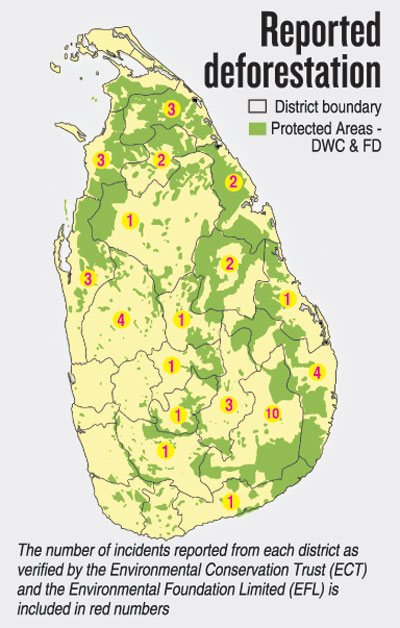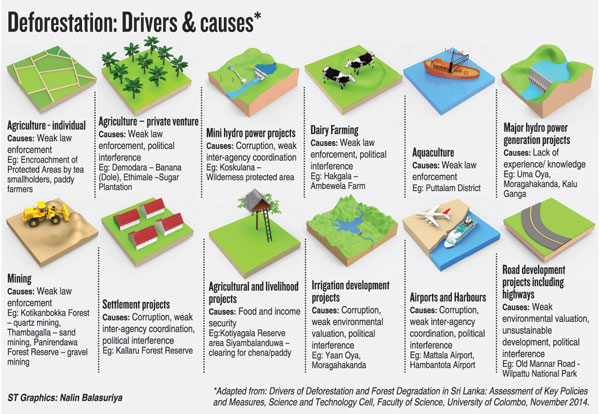News
Help halt forest destruction

The panel (from left) EFL Director Dr. Sevvandi Jayakody; former Director-General of the Department of Wildlife Conservation, Dr. Sumith Pilapitiya; WNPS President Rukshan Jayewardene; and ECT Director Sajeewa Chamikara. Pic by Nilan Maligaspe
The plea is directly to the most powerful person in Sri Lanka – none other than President Maithripala Sirisena himself.
Put a stop to the rapid deforestation of the country, otherwise the consequences would be disastrous, is the urgent request going out from top environmentalists, as already the impact of such deforestation is being tragically experienced in the nook and crannies of the country, in the form of debilitating droughts and incessant rains.
With the main government agency allegedly responsible for the destruction of forests being the Mahaweli Authority, this strong plea was sent out to President Sirisena to rein it in, as he holds both portfolios of Mahaweli and Environment.
The time is right now, with the President’s laudable commitment to increasing the forest cover to 32%, to immediately halt the denudation of the precious existing forests, was the consensus among the four environmentalists at a media briefing on Tuesday.
The in-depth description of the forest-cover destruction and the mere fact that no one really knows exactly how much of Sri Lanka’s forest cover is left and what exactly is defined as forest cover were also highlighted at the briefing.
To show that they ‘walk the talk’, the organisers of the media briefing, the Environmental Foundation Limited (EFL) and the Federation of Environmental Organisations (FEO) sent all invites digitally and also printed the handouts on already-used paper, said FEO’s Coordinating Trustee Praveen Abhayaratne. True to their word, there were also no plastic bottles of water on the tables but glass jugs of water with glasses.
The briefing titled ‘Deforestation in Sri Lanka – Water security, food security and habitat security’ was all encompassing.
Specific instances of forest destruction and proposed deforestation by the Mahaweli Authority were brought into the spotlight by the Director of the Environment Conservation Trust (ECT), Sajeewa Chamikara.
Here are the areas under threat due to the Mahaweli L zone, according to him:
* In Mullaitivu, 6,000 acres of jungle, bordering the Andankulam Forest Reserve and the Kokilai Sanctuary are being cleared and destroyed. A majority of those who have got land in this area are big businessmen and not small farmers.
* Nearly 32,000 acres of land in the Padaviya Forest Reserve are being cleared for potential development. This Forest Reserve covering 48,451 acres was declared by Gazette No. 1793/21 on January 18, 2013, but soon after, 31,875 acres were de-gazetted by Gazette No. 1808/4 on April 29, 2013.
* Around 22,500 acres of forest in the Medirigiriya-Bisopura area have been handed over for development.
A few other areas where forest destruction is taking place:
* Around 20,000 acres of forests in Welikanda have been handed over to big businessmen for massive commercial cultivations.
* Around 5,000 acres from the Karunkalipuram Forest Reserve have been released for the settlement of people.
* There are major intrusions into the Proposed Elephant Management Reserve in Hambantota, in the form of large-scale soil excavation, metal-quarrying, setting up of solar power plants and commercial crop cultivations.

Quoting the famous saying of British Prime Minister Benjamin Disraeli on the three kinds of lies, “Lies, damned lies and statistics”, the President of the Wildlife and Nature Protection Society (WNPS), Rukshan Jayewardene stressed that the Forest Department is “cooking up figures” to suit the occasion.
Referring to the percentage of forest lands, he stressed that statistics can be used to falsify information and give a wrong picture of ‘facts’ that are dubious. “People don’t challenge statistics but statistics are used to obscure and obfuscate the truth.”
In Sri Lanka, according to Mr. Jayewardene the percentage of forest lands goes up or down, depending on whose statistics they are. Pointing a finger directly at the Forest Department which is expected to be a responsible government agency, he was categorical that the figures given by it are confusing and perplexing.
He also questioned what the actual definition of ‘forest cover’ is. Does it include closed canopy natural forests, sparse forests, forest plantations, dense forests, mangrove forests, savanna forests, primary forests, naturally-regenerated forests and planted forests? Should forest cover include scrub jungle and natural green cover? Sometimes forest cover could be green cover because everything looks alike. Would this include coconut and rubber lands? Plantation forests are unequal to natural forest cover in the role they play in terms of water and soil conservation. Monoculture forests such as pinus and eucalyptus may be a substitute to forest cover, but will never be its equal.
“Baseline data on forest cover is vital,” he said, adding that while satellite imaging could identify such areas, this would just not be enough. Field officers need to be sent to these areas to match such data with old maps.
Making an “educated guess”, he estimated that the forest cover in Sri Lanka is below 20%.
Another allegation levelled by Mr. Jayewardene was that the Forest Department logs the forests, but no one really knows what happens to all that valuable timber.
Regarding the use of land for development, Mr. Jayewardene was quick to point out that although there is a lot of wasteland (mudu bim), development projects were always earmarked for areas where there was valuable forest cover.

| Need to think of country and not the next election – Dr. PilapitiyaTaking the journalists back in time, the former Director-General of the Department of Wildlife Conservation (DWC), Dr. Sumith Pilapitiya described how the ancient rulers managed the forest cover in the country.The central highlands have thick forests while the Dry Zone does not have adequate water and is drought-stricken. But the ancients developed the Dry Zone rather than the central highlands. Why, he asked. “This was to save the central highlands which had within its fold the watershed areas. The ancients were masters at ‘sustainable development’ even though that term had not even been coined then. They were also more concerned about the nation’s development rather than the next election,” he said. Looking at deforestation from the 1800s to 1985, Dr. Pilapitiya pointed out that it was carried out for the cultivation of plantation crops for export, timber exploitation and land settlement. After 1985, equal or more harm was done and continues to be done for four drivers – encroachment largely with the complicity of politicians, infrastructure and private and government ventures which include medium and long-term projects. However, most of these have not yielded the high benefits expected of them. Deforestation goes on unabated, said Dr. Pilapitiya, adding that political interference was a catalyst while there was poor or sub-optimal coordination among government agencies engaged in implementing the Land Policy. What many people forget is that forests are not only valuable for their timber but also play a pivotal role in providing ecosystem services. He said: “There is a misconception that small Sri Lanka cannot be a big contributor to climate change. But what we forget is that Sri Lanka is an island with limited land space, declining natural resources and an increasing population. The system will surely collapse, unless we do something right now. Otherwise, we are heading for disaster.” Explaining that an integral part of the government’s good governance policy should be proper management of the environment, he stressed that mismanagement would be a form of corruption because we are depriving future generations of their rightful heritage. Sri Lanka has the best regulatory framework but it is not implemented largely due to political pressure. “Give freedom to the relevant agencies to implement the law to the letter and then hold them accountable,” urged Dr. Pilapitiya. |
| Ways to protect valuable forestsHere are the recommendations by the EFL and the FEO to curtail further deforestation and protect water resources* The strict enforcement of existing environmental laws * The protection of major catchment areas and riverine forests * Linking-up of fragmented forest areas through jungle corridors * The rehabilitation of the cascade systems * Mahaweli, Land Reform Commission and Plantation Corporation forest lands should be taken over by the Forest Department or the Department of Wildlife Conservation * Temple lands should be protected from development activities * Incorporation of strategic planning methods to prevent unnecessary forest clearance |
| Valuable data kept under lock and key and lost forever – Dr. JayakodyForest Department estimates suggest that the total forest cover of Sri Lanka is currently about 1.95 million hectares which represent 29.7% of the total land area, said EFL Director Dr. Sevvandi Jayakody, garnering the figures from the UN-REDD (the United Nations Programme on Reducing Emissions from Deforestation and Forest Degradation) website. The denudation of forests can be linked to the growth of the export plantation economy; commercial timber extraction policy; and land settlement and irrigation development in the Dry Zone, according to her. Why are forests important and why does it matter when forests are cut down, asked Dr. Jayakody, reiterating that forests play an important role in biodiversity, indigenous wildlife, food for all, raw material for industry, bio-fuel, energy-conservation benefits and also act as barriers in the spread of disease. Getting back to statistics, she said that according to UN-REDD, there is a steady annual deforestation rate of over 7,000 hectares spread throughout the country. The deforestation is higher in the northeast Dry Zone compared to the southwest Wet Zone. She pointed out that a National Conservation Review (NCR) was conducted “to define a national system of conservation of forests in which watersheds important for soil conservation and hydrology are protected, forest biodiversity is fully represented and cultural, economic and social needs are met”. Before the NCR, an Accelerated Conservation Review of 30 lowland rainforests was carried out. The NCR collected data from across the country except in the north and the east from 1991 to 1996, with forests over 200 hectares being assessed for biodiversity, hydrology and soil conservation. The NCR is among the most detailed, comprehensive and innovative evaluations of its kind carried out in any tropical country, she said. Dr. Jayakody’s lament was that since the publication of the NCR in 1997, no action has been taken to date, to declare and protect the 85 forests identified as extremely important for soil protection and flood control or interception of fog in the case of those located above 1,500 metres. The NCR was never used. The data were kept under lock and key and now they are gone, she said, adding that she herself served on two committees appointed under two Ministers to enact the NCR recommendations which never happened.
|

